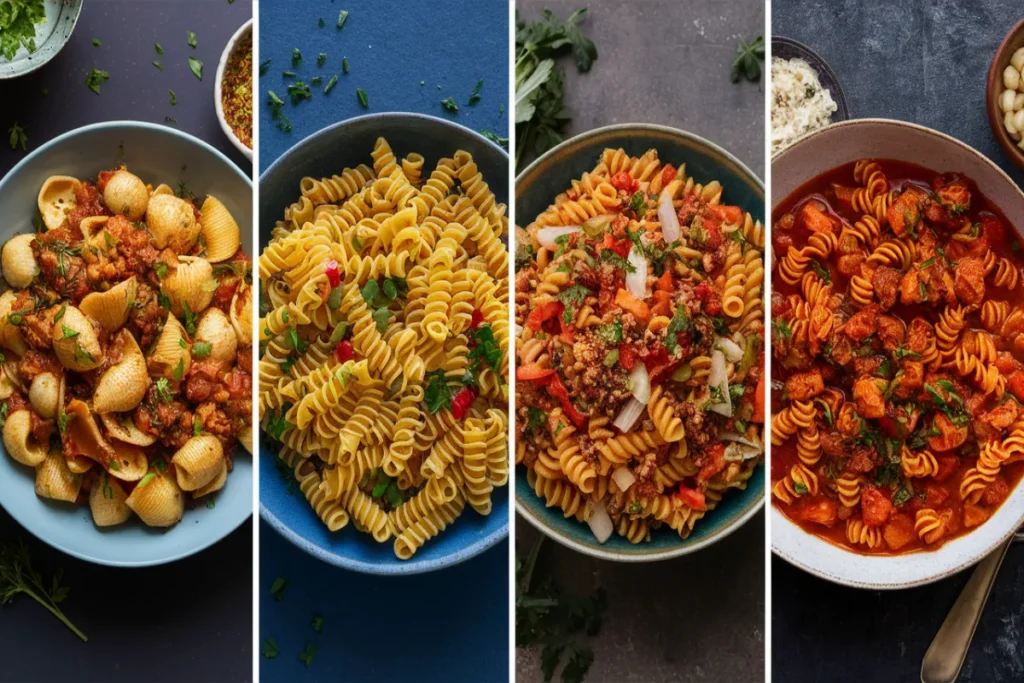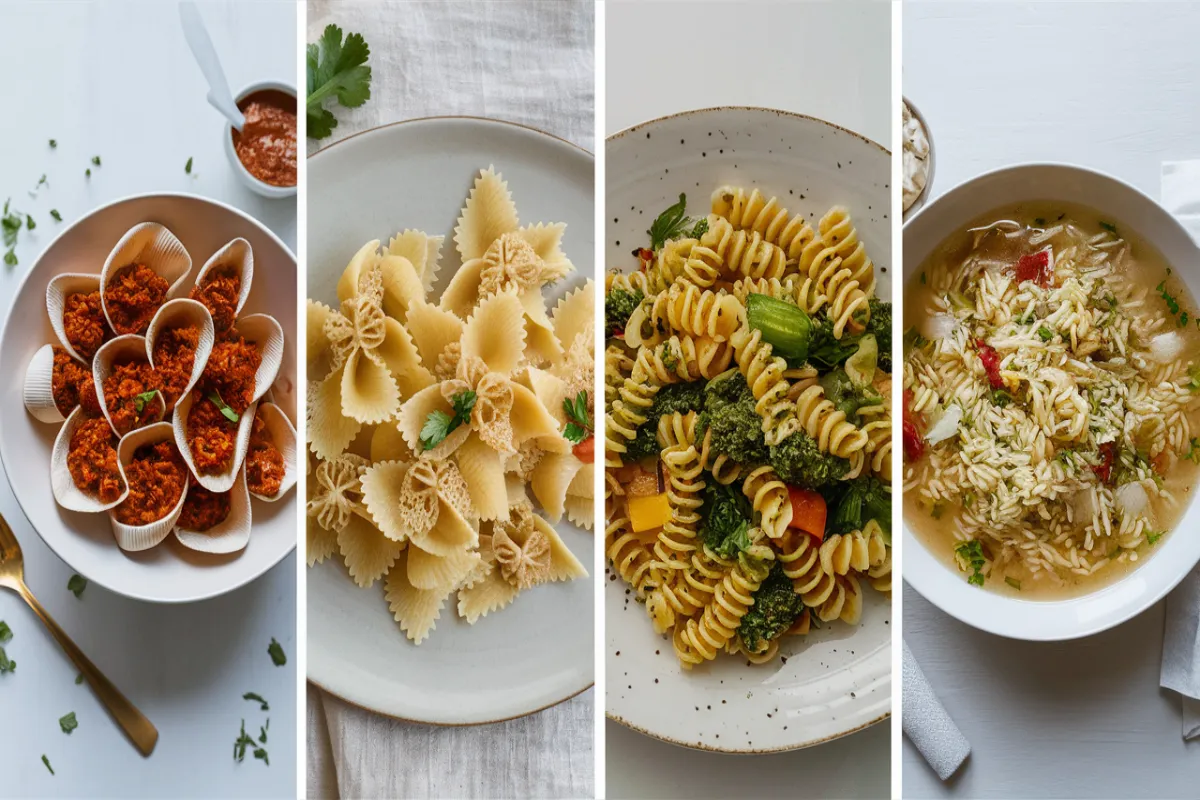Orecchiette, a delightful and traditional Italian pasta, is renowned for its “little ears” shape, which makes it perfect for holding onto thick sauces, vegetables, and other flavorful ingredients. But what can you substitute for orecchiette if you can’t find it in your local store or simply want to try something different? This guide will dive deep into the best substitutes for orecchiette, covering their texture, flavor, and how well they work with various sauces and recipes. We’ll explore different types of pasta that can stand in for orecchiette, give tips for making these substitutions, and help you create dishes that are just as satisfying. This comprehensive article will also cover frequently asked questions, pairing suggestions, and tips for achieving the best results when substituting for orecchiette.
Why Is Orecchiette Special?
Before diving into substitutes, it’s important to understand why orecchiette is unique. The name orecchiette comes from the Italian word for “little ears,” which accurately describes this pasta’s concave shape. Originating from the Puglia region in southern Italy, this pasta’s small, cupped shape makes it ideal for catching and holding chunky sauces, vegetables like broccoli rabe, or beans like chickpeas.
Orecchiette’s texture is slightly chewy, which adds an extra layer of complexity when paired with heartier sauces. The pasta is often handmade, with the dough pressed and shaped to form small discs that cup ever so slightly. This traditional process, coupled with orecchiette’s versatility, is why it’s beloved in Italian cuisine. However, if you don’t have orecchiette available or want to experiment, there are several alternatives that can mimic its performance in recipes.
What Can I Substitute for Orecchiette?
The keyphrase “What can I substitute for orecchiette?” is an essential question for anyone looking to recreate dishes that call for this unique pasta. Below, we explore the best alternatives that can closely replicate orecchiette’s qualities.
1. Shells (Conchiglie)
Texture and Shape:
Shells, also known as conchiglie, are one of the closest substitutes for orecchiette. Their cup-like shape makes them excellent for holding sauces and small bits of ingredients like vegetables and meats. Their slightly larger size makes them perfect for catching chunkier elements of a sauce.
Why It Works:
Like orecchiette, shells can hold thick sauces and chunky ingredients, making them an excellent alternative in recipes where you want a similar texture and bite. They’re especially good for creamy sauces, meat sauces, and vegetable-based dishes.
Best Used In:
Use shells in recipes like pasta with broccoli rabe and sausage, creamy Alfredo-style dishes, or hearty tomato-based sauces.
2. Cavatelli
Texture and Shape:
Cavatelli is another southern Italian pasta, and its small, rolled shape makes it a perfect stand-in for orecchiette. Like orecchiette, cavatelli has a ridged, slightly chewy texture, making it ideal for pairing with chunky sauces and ingredients.
Why It Works:
The ridged texture of cavatelli allows it to cling to sauces just as effectively as orecchiette. Its slightly smaller size also makes it a great substitute for pasta salads and soups where you want a more delicate appearance without losing texture.
Best Used In:
Cavatelli shines in dishes that feature chunky vegetables like zucchini or broccoli, as well as in pasta salads where you need a smaller, textured pasta to stand out.
3. Farfalle (Bow Tie Pasta)
Texture and Shape:
Farfalle, commonly known as bow tie pasta, is flatter than orecchiette but still has the ability to hold onto sauce due to its creased center. The edges of the bow tie pasta give a unique mouthfeel that differs from the roundness of orecchiette but still holds its own.
Why It Works:
Farfalle’s shape may be different, but its texture and ability to hold onto sauces make it a good substitute when orecchiette isn’t available. The flat, creased shape of farfalle offers a nice contrast to smooth or chunky sauces.
Best Used In:
Farfalle is ideal for lighter cream-based sauces, simple olive oil and garlic dishes, and vegetable-forward recipes. It’s also a popular choice for pasta salads.
4. Fusilli
Texture and Shape:
Fusilli are short, corkscrew-shaped pasta that do an excellent job of holding onto sauce. Their spiral shape traps sauces between the ridges, making them a great substitute for orecchiette in heartier dishes.
Why It Works:
The spiral shape of fusilli allows it to cling to thick, textured sauces just like orecchiette. Its structure adds a bit of fun to any dish, and it works especially well with thicker tomato-based sauces or pesto.
Best Used In:
Fusilli is great for heavy meat sauces, pesto, or vegetable sauces. It’s also versatile enough to be used in cold pasta salads with lighter vinaigrettes.
5. Rotini
Texture and Shape:
Rotini is similar to fusilli but slightly tighter in its spiral shape. The close coils trap sauces beautifully, making it a reliable substitute for orecchiette when you need a pasta that can hold onto rich flavors.
Why It Works:
Rotini’s texture and shape allow it to work well in recipes that require a pasta capable of catching both sauce and small ingredients like peas or diced tomatoes. It’s also a solid choice for creamier or oil-based sauces.
Best Used In:
Rotini pairs well with creamy sauces, chunky tomato sauces, or as the base for a cold pasta salad with vegetables and tangy vinaigrettes.
6. Orzo
Texture and Shape:
Orzo is a rice-shaped pasta that offers a completely different texture from orecchiette, but it works as a substitute in soups and lighter pasta dishes where a smaller, delicate pasta is required.
Why It Works:
Orzo’s small size allows it to blend well into soups and salads. While it doesn’t have the cup shape of orecchiette, its size and ability to absorb flavor make it a great alternative in dishes where you need a softer, more subtle pasta.
Best Used In:
Orzo works well in brothy soups, light pasta salads, or simple olive oil-based dishes with fresh herbs and vegetables.
7. Ditalini
Texture and Shape:
Ditalini is a small, tube-shaped pasta that works well in soups and stews where you want a more subtle texture. While it lacks the cupping shape of orecchiette, its short tubular structure makes it a viable alternative.
Why It Works:
Ditalini is a good substitute for orecchiette in dishes that require a small pasta capable of holding onto bits of sauce or broth. It’s often used in Italian soups like minestrone and works well with bean-based dishes.
Best Used In:
Use ditalini in soups, stews, or even in pasta salads that require smaller pasta shapes to blend well with other ingredients.
How to Use Pasta Substitutes in Orecchiette Recipes

Now that you have some ideas for substitutes for orecchiette, let’s discuss how to successfully implement them into your cooking. Here are some tips to make the substitution process smooth and seamless:
1. Consider the Sauce
One of the main reasons orecchiette works so well in many dishes is because of its ability to hold onto chunky sauces. When selecting a substitute, choose a pasta with a similar ability to hold sauce—like shells, fusilli, or rotini—for the best results. Speaking of substitution, it’s fascinating how substitution strategies also play a significant role in sports. Learn more about substitution strategies in sports here. If you’re using a lighter sauce, such as an olive oil-based one, you can experiment with smaller pasta shapes like orzo or ditalini.
2. Adjust Cooking Times
Different types of pasta have different cooking times. Always check the package instructions for the substitute pasta you are using to ensure you don’t overcook or undercook it. Pasta should be cooked al dente, with a slight bite to it.
3. Match Texture and Size
When substituting pasta, consider the texture and size of the substitute relative to orecchiette. For example, if you’re making a hearty dish with sausage and broccoli rabe, a thicker pasta like fusilli or shells would work best. If the dish is more delicate, such as a pasta salad, a smaller pasta like orzo or ditalini may be a better choice.
4. Experiment with New Recipes
Substituting pasta is also an opportunity to experiment with new recipes. For instance, if you’re replacing orecchiette with cavatelli or fusilli, you may want to try pairing the dish with a different type of sauce or different vegetables to see how the new combination works.
Pairing Suggestions for Orecchiette Substitutes

When substituting for orecchiette, it’s important to consider the sauce and other ingredients to ensure a balanced dish. Here are some pairing suggestions for common pasta substitutes:
1. Shells (Conchiglie)
Pair shells with hearty, chunky sauces like Bolognese, creamy Alfredo, or vegetables like broccoli rabe and sausage. The cup-like shape of the shells will hold the sauce and ingredients perfectly.
2. Farfalle (Bow Tie Pasta)
Farfalle pairs well with lighter, cream-based sauces and olive oil-based dishes. It’s also a great option for pasta salads, thanks to its unique shape and texture.
3. Fusilli or Rotini
These spiral-shaped pastas work best with pesto, tomato-based sauces, or vegetable-forward dishes. Their shape makes them excellent for trapping bits of sauce and vegetables.
4. Orzo or Ditalini
Orzo and ditalini are best suited for soups, brothy dishes, or cold pasta salads. Their small size makes them ideal for lighter, more delicate dishes where a larger pasta would overwhelm the other ingredients.
Frequently Asked Questions (FAQs)
Q: What can I substitute for orecchiette in a recipe?
A: Some of the best substitutes for orecchiette include shells (conchiglie), cavatelli, farfalle (bow tie pasta), fusilli, rotini, orzo, and ditalini. These pasta shapes can all hold onto sauces in similar ways to orecchiette, making them great alternatives.
Q: Can I use a gluten-free pasta as a substitute for orecchiette?
A: Yes, many gluten-free pasta varieties come in similar shapes to orecchiette. You can find gluten-free shells, fusilli, or rotini made from rice, quinoa, or chickpeas, all of which work well as substitutes.
Q: Which pasta is the closest substitute for orecchiette?
A: Shells (conchiglie) are the closest substitute for orecchiette due to their similar cupped shape and texture, making them ideal for holding sauces and ingredients in much the same way.
Q: How do I choose the right substitute for orecchiette in my dish?
A: Consider the sauce and ingredients in your dish. If you’re making a dish with a chunky sauce or vegetables, choose a pasta that can hold those ingredients, like shells, fusilli, or rotini. For lighter dishes or soups, opt for smaller pasta like orzo or ditalini.
Q: Can I make orecchiette at home if I can’t find it in stores?
A: Yes! Making orecchiette at home requires basic ingredients like flour and water. The dough is rolled into small discs, then shaped by pressing and pulling with your thumb. While it takes practice, homemade orecchiette is a rewarding and delicious alternative.
Q: Are there any specific sauces that pair better with orecchiette substitutes?
A: Hearty, chunky sauces work best with larger substitutes like shells, fusilli, or rotini, while lighter sauces or soups are better paired with smaller pasta like orzo or ditalini. Experiment with different combinations to see what works best for your dish.
Final Thoughts
When asking, “What can I substitute for orecchiette?” you have plenty of great options to choose from. Shells, cavatelli, farfalle, fusilli, rotini, orzo, and ditalini all bring their own qualities to the table, ensuring that your recipes will turn out just as delicious, even without orecchiette. Whether you’re making a hearty dinner or a light lunch, these pasta substitutes will help you achieve the perfect balance of texture and flavor. Now that you know the best alternatives for orecchiette, you can confidently swap in different pasta shapes and continue to enjoy your favorite dishes.

